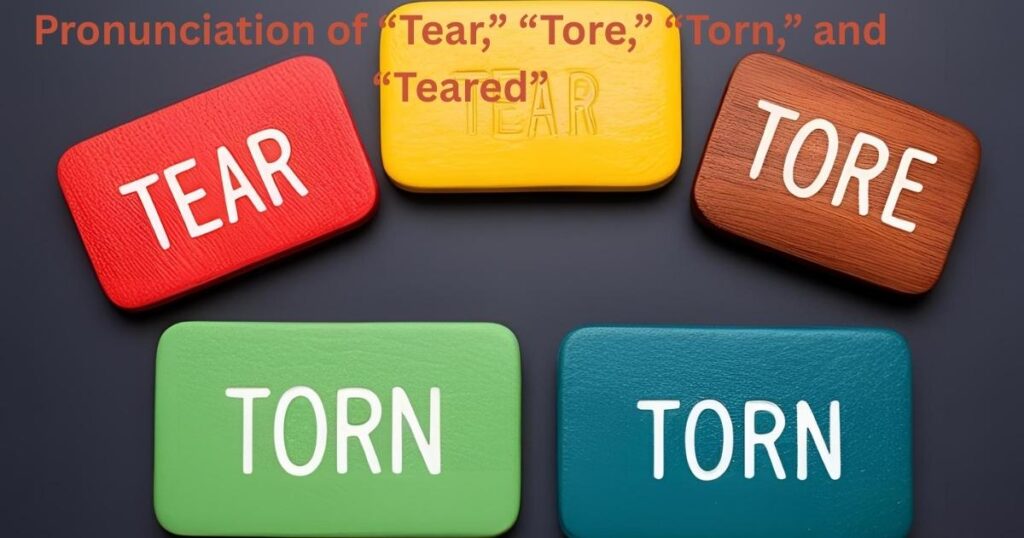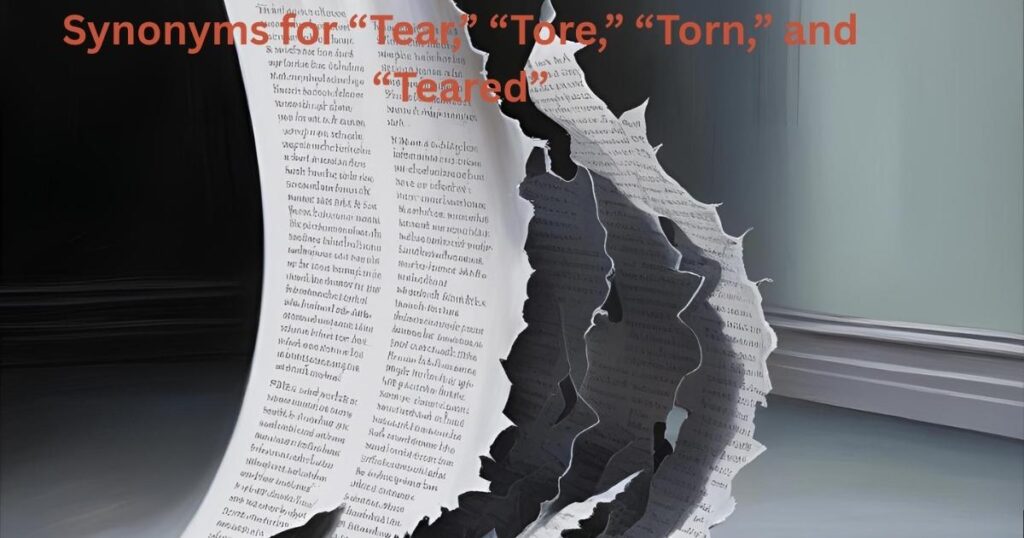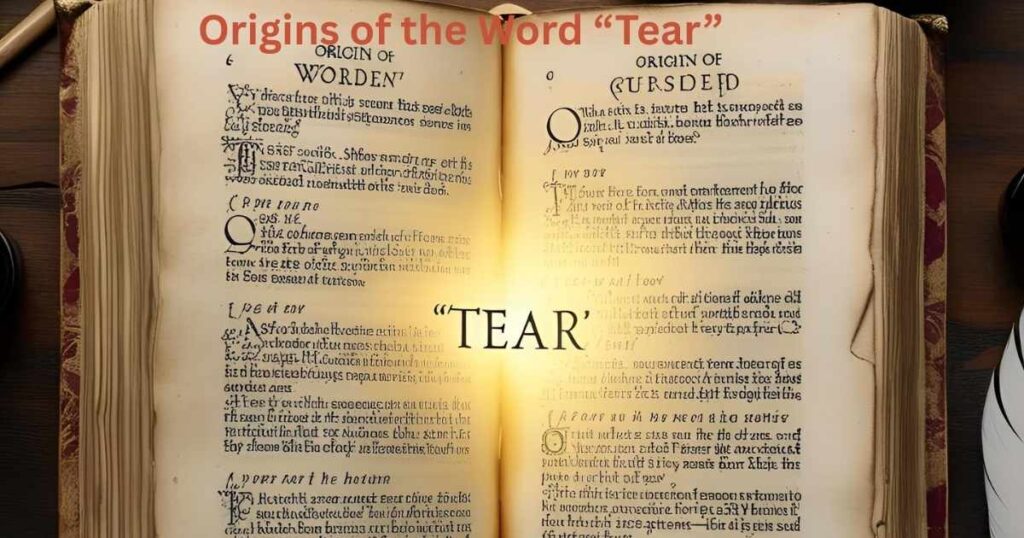Understanding irregular verbs in English can be tricky, especially when a single word carries more than one meaning. The verb “tear” is a perfect example,it can mean to rip something apart or to cry. This leads to a common and frustrating question: What’s the past tense of tear? Is it “tore,” “torn,” or “teared”? The confusion grows when these forms are used in different contexts, both physically and emotionally.
Learners often ask, what’s the past tense of tear, and even native speakers find themselves second-guessing. To make things clearer, this article dives into each form,when to use “tore,” how “torn” works as a past participle, and why “teared” only fits certain situations. So if you’ve ever paused and wondered, what’s the past tense of tear, you’re in the right place.
Why is There Confusion?

The confusion mostly comes from the fact that tear is one of those tricky English verbs with more than one meaning. It can mean “to rip something apart,” like a dress or pages, but it can also mean “to cry” or to produce tears, the fluid that comes from your eyes. These two meanings sound the same when spoken but have different grammatical forms, tenses, and sometimes even different past tense structures. For example, when you’re talking about ripping, you use “tore” or “torn.” But when you’re talking about crying, it’s often “teared” or “teared up.”
People often get mixed up because they assume all past tense forms are regular and just add “-ed” to the end of the verb. That’s how we end up with people saying things like, “He tore the paper,” when they really mean, “He tore the paper.” The grammar rules in English, especially for irregular verbs, can be confusing at times. This is even more challenging for ESL learners, and even some fluent speakers stumble with these variations. As seen in online forums and even tweets from people like Trevor, Stella, and Josh, it’s a common mix-up that leads to debates on the correct usage.
Also Read: What’s the Past Tense of Cost: Is It Cost or Costed?
What Does the Word “Tear” Mean?
“Tear” can be used in many ways depending on the context and the verb form. As a verb, it often means to pull something apart forcefully,like when you tear a shirt, shred a document, or rip a poster off the wall. That’s the more physical or violent sense of the word, and it’s common in sentences about damage, destruction, or movement. For example, in a movie scene where someone ripped open a gift, you’d say, “She tore the wrapping paper in excitement.”
But “tear” also means to weep,to shed tears when you’re sad or emotional. It can happen when someone is watching a sad movie or reading a touching letter. Someone might say, “He teared up at the wedding,” showing a different type of expression and emotion. This emotional form has its roots in different linguistic influences and changes the verb tense that’s correct. It’s why we sometimes see “teared” used instead of “tore,” especially when referring to crying. Both meanings use the same spelling in the present but follow very different paths when changing to past or past participle forms.
The Past Tense of “Tear”
Now to the heart of the question: what’s the past tense of tear? When “tear” is used to mean to rip, the correct simple past tense is “tore.” You might say, “He tore his jeans while jumping over the fence.” The past participle form, used with auxiliary verbs, is “torn.” For example, “The pages were torn by accident.” These forms follow an irregular verb pattern that comes from older roots in Old English, Old Norse, and Proto-Germanic;the word evolved over centuries, influenced by sources like Old Frisian, Old Saxon, and Old High German.
On the other hand, “teared” is usually considered correct only when used in the emotional sense, meaning to cry. So if you say, “He teared up during the speech,” it’s grammatically okay. But saying, “He tore the paper,” is incorrect,tore should be used instead. According to Merriam-Webster and Wikipedia, this confusion stems from overlapping meanings and a desire to regularize irregular words. Language expert Marshall explains that our brains sometimes automatically add “-ed” to make a verb past tense, but that doesn’t always work in English.
Pronunciation of “Tear,” “Tore,” “Torn,” and “Teared”

Pronunciation plays a big role in this confusion. The present tense “tear” (rip) is pronounced /tɛr/, while “tear” (eye drop) is pronounced /tɪr/. Even though the spelling is the same, their sounds are different. That’s what linguists call homographs,words that look alike but are said differently and have different meanings. For “tore,” the pronunciation is /tɔːr/, and “torn” is /tɔːrn/. “Teared,” when referring to crying, is pronounced /tɪrd/ or /tiːrd/, depending on dialect.
If you’re reading out loud, these pronunciation cues help your listener understand whether you mean someone ripped a paper or cried during a scene. In a sentence like “She teared up watching the documentary about August and his dog Mustang,” the emotional tone and context make it clear you’re not talking about ripping anything. Mispronunciations are common, especially among young learners or people picking up English as a second language. Tools like Etymonline, pronunciation guides, or even asking your friend Ramiz for clarification can go a long way.
A Simple Table Showing the Present, Past, and Future Tense of the Verb “Tear”
| Tense | Verb Form | Example Sentence |
| Present Simple | tear | I tear the wrapping paper. |
| Past Simple | tore | He tore the letter in anger. |
| Past Participle | torn | The fabric has been torn for years. |
| Present Continuous | tearing | She is tearing the cloth into strips. |
| Future Simple | will tear | They will tear down the old building. |
| Present Perfect | have torn | We have torn up the contract. |
Examples of “Tear,” “Tore,” “Torn,” and “Teared” in Sentences
Understanding tenses is easier when you see them in real sentences. You might hear Joe say, “I tear up every time I hear that song.” That’s a present tense sentence about crying. Or someone could say, “She tore the envelope open.” That’s past tense, referring to ripping. And then there’s, “The flag was torn during the storm,” which uses the past participle in a passive voice. “He teared up when he saw his childhood home,” refers to the emotional use again, a completely different scene.
Each version fits a specific context. Using them incorrectly can change the entire meaning of your sentence or make it confusing. Imagine saying, “He tore the book” when you really meant “tore”,it sounds off, doesn’t it? That’s why knowing the differences isn’t just about grammar, it’s about clear communication.
Tear (The Present Tense)
The present tense “tear” is used when the action is happening now. It applies to both meanings: to rip or to cry. For example, “They tear down old buildings every July,” shows an action in progress. “I tear up during emotional scenes in movies,” refers to the emotional version. Both versions are correct, but their usage depends on what you’re talking about,physical action or emotional expression. It’s important to read the context of a sentence to know which meaning is being used.
Tore (The Simple Past Tense)
“Tore” is always the correct simple past tense when you’re talking about pulling, ripping, or breaking something apart. You could say, “She tore the package open in excitement,” or “They tore through the streets in their new Mustang.” This form is energetic, sometimes even violent, used to show force or urgency. Saying “He tore the paper” instead of “store” is incorrect unless you mean someone cried on the paper.
Torn (The Past Participle)
The word “torn” works with helping verbs like “has,” “have,” or “was.” You’d say, “The jeans were torn after the accident,” or “She has torn up the invitation.” It’s a common way to express damage, either physical or emotional. Phrases like “torn apart by grief” even use it metaphorically. The past participle form reflects not just what happened, but often what’s still affecting someone or something now. It’s deep and expressive.
Teared (The Past Tense of Tear for Crying or Shedding Tears)
“Teared” is used when talking about crying, not ripping. For example, “Josh teared up when he saw the old footage from 1917.” While “tire” is for physical action, “teared” shows emotion, sadness, or being choked up. You’ll often hear it used in movies, books, or personal conversations. It adds depth to a character or scene, making it more human and real.
Synonyms for “Tear,” “Tore,” “Torn,” and “Teared”

Understanding synonyms can help improve your writing and speaking. They offer variety and clarity, especially when you want to avoid repetition or sound more natural. Each form of “tear” has its own set of semantically related alternatives.
Synonyms for “Tear” (Present Tense)
Some options include rip, shred, split, flay, and lacerate. For crying, use cry, weep, or sob. These words carry similar meanings and can shift the tone of your message depending on how intense or emotional you want to sound.
Synonyms for “Tore” (Simple Past Tense)
You might use ripped, shredded, pulled apart, flayed, or destroyed. All of these suggest a completed action involving force or violence. For emotional past, think of weeping or sobbed.
Synonyms for “Torn” (Past Participle)
Alternatives include mangled, crushed, lacerated, broken, or even damaged. Each gives a different level of intensity or condition of the object or person affected. These are great for emotional storytelling or describing accidents.
Synonyms for “Teared” (Past Tense for Crying)
Try words like cried, wept, sobbed, broke down, or choked up. These phrases give emotional weight to the moment and help paint a vivid picture.
Origins of the Word “Tear”

The word “tear” has a long and fascinating history. It comes from Old English “teran” (to rip) and tearu (a teardrop). The verb form related to ripping came from Proto-Germanic and Old Norse, while the emotional form traces back to Proto-Indo-European (PIE) roots. According to Etymonline, “tear” has undergone shifts in spelling, meaning, and usage since as early as 1300.
Different cultures shaped its use. Greek, Latin, and Middle Dutch all had similar words that described breaking, pulling, or crying. As English evolved, both meanings remained, which is rare for most verbs. This split in etymology explains why “teared” and “tore” can exist in the same language but serve different roles.
The Noun “Tear” (The Fluid Drop from the Eye)
This form of “tear” refers to the little drop of salty fluid that falls when we cry. It’s a noun, not a verb, and it comes from Old English tearu. Tears can be happy or sad, and they’ve always been a strong symbol in literature and film. In grammar, this word is used mostly in emotional or biological contexts.
The Verb “Tear” (To Rend or Pull Apart by Force)
This is the original use of the verb, rooted in violent, physical action. It can apply to clothing, paper, skin (lacerations), or even emotionally torn situations. The action usually involves force, speed, or frustration.
The Verb “Tear” (To Weep or Cry)
This version refers to crying, and is usually used in emotional situations. “Tear up” is the most common form. Someone might say, “She teared up when she heard the news.” It’s soft, emotional, and personal.
The Noun “Tear” (A Tearing or Laceration)
This refers to the result of something being ripped, like a wound, cut, or hole. You might hear it in a medical setting or while talking about clothing: “There’s a tear in my jeans.”
The Verb “Tear” (To Move Noisily)
Used mostly in idioms, this version describes fast, frantic movement. Think of someone “tearing through the streets” in a Mustang. It suggests noise, urgency, or even chaos.
Conclusion
English can be confusing, especially with words like “tear.” You might stop and ask, what’s the past tense of tear? Is it “tore”? Could it be “torn”? Or even “teared”? The answer depends on how you use the word. What’s the past tense of tear when you mean ripping something? It’s “tore.” But if you’re using the past participle, it’s “torn.” If you’re crying, you say “teared.”
So next time you wonder, what’s the past tense of tear, think about the meaning. Is it about crying or ripping? That helps you choose the right word. Now you won’t have to ask again, what’s the past tense of tear? You know it. You understand it. And you can use it the right way. That’s the power of learning grammar clearly.

Gramcoachpro is your go-to platform for mastering grammar, writing, and communication skills. If you’re a student, teacher, or content creator, we provide easy-to-understand tips, examples, and tools to improve your language — fast and effectively. Our mission is to make better writing simple and accessible for everyone.

